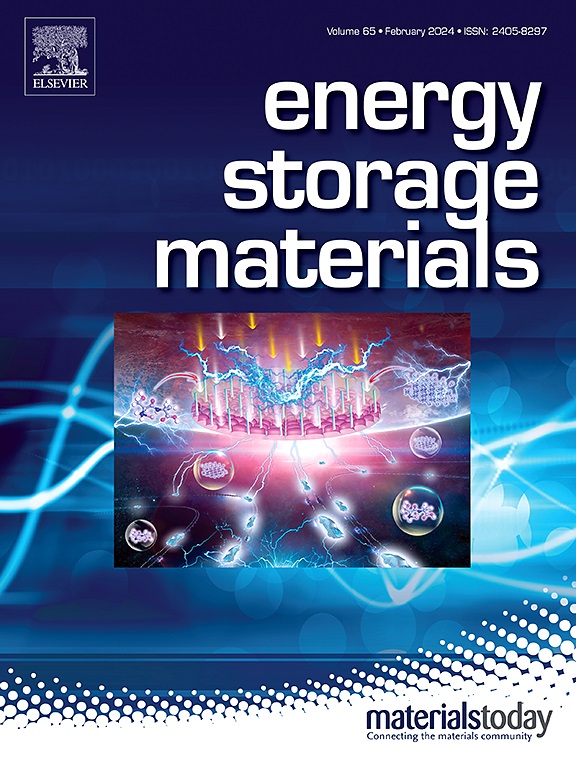天然真黑素胶体电解质的理化协同界面优化实现高可逆锌阳极
IF 18.9
1区 材料科学
Q1 CHEMISTRY, PHYSICAL
引用次数: 0
摘要
水溶液锌离子电池(AZIBs)因其成本低、无毒、本质安全等优点而受到广泛关注,但存在枝晶锌生长、析氢反应严重和腐蚀等缺点。本文提出了一种具有物理化学协同效应的天然真黑素(NE)胶体电解质,用于实现高可逆的锌阳极。NE丰富的极性官能团与Zn2+产生强烈的相互作用,进一步重新配置Zn2+离子的溶剂化结构,提高Zn2+的转移动力学,而纳米结构的NE可以物理填充Zn阳极上的缺陷,并重新分配电场,使Zn沉积致密。得益于物理化学协同策略,ne基胶体电解质使Zn阳极具有高达98.82%的高库仑效率,而Zn/ Zn对称电池在5 mA cm - 2/1 mAh cm - 2下具有高度可逆的恒流镀/剥离超过3,800 h,并且具有超过9,500 mAh cm - 2的超高累积镀容量。这种物理化学协同界面优化策略为实现高可逆锌阳极提供了一种很有前途的方法。本文章由计算机程序翻译,如有差异,请以英文原文为准。


Physicochemical synergistic interface optimization via natural eumelanin colloidal electrolyte enables highly reversible Zn anodes
Aqueous zinc-ion batteries (AZIBs) have gained significant attentions as a promising energy storage system due to their low cost, non-toxicity and intrinsic safety, but suffer from dendritic Zn growth, grievous hydrogen evolution reaction and corrosion. Here, a natural eumelanin (NE) colloidal electrolyte capable of physicochemical synergistic effect was proposed to realize highly reversible Zn anodes. The abundant polar functional groups of NE generate strong interaction with Zn2+ and further reconfigure the Zn2+ ions solvation structure to improve the Zn2+ transfer kinetics, while the nanostructured NE can physically fill the defects on Zn anode and redistribute the electric field for compact Zn deposition. Benefitting from the physicochemical synergistic strategy, the NE-based colloidal electrolyte enables Zn anodes with a high coulombic efficiency of 98.82 %, while the Zn//Zn symmetric cell exhibited highly reversible galvanostatic plating/stripping for >3800 h at 5 mA cm−2/1 mAh cm−2 and an ultra-high cumulative plating capacity exceeding 9500 mAh cm−2. This physicochemical synergistic interface optimization strategy provides a promising approach to achieving highly reversible Zn anodes.
求助全文
通过发布文献求助,成功后即可免费获取论文全文。
去求助
来源期刊

Energy Storage Materials
Materials Science-General Materials Science
CiteScore
33.00
自引率
5.90%
发文量
652
审稿时长
27 days
期刊介绍:
Energy Storage Materials is a global interdisciplinary journal dedicated to sharing scientific and technological advancements in materials and devices for advanced energy storage and related energy conversion, such as in metal-O2 batteries. The journal features comprehensive research articles, including full papers and short communications, as well as authoritative feature articles and reviews by leading experts in the field.
Energy Storage Materials covers a wide range of topics, including the synthesis, fabrication, structure, properties, performance, and technological applications of energy storage materials. Additionally, the journal explores strategies, policies, and developments in the field of energy storage materials and devices for sustainable energy.
Published papers are selected based on their scientific and technological significance, their ability to provide valuable new knowledge, and their relevance to the international research community.
 求助内容:
求助内容: 应助结果提醒方式:
应助结果提醒方式:


